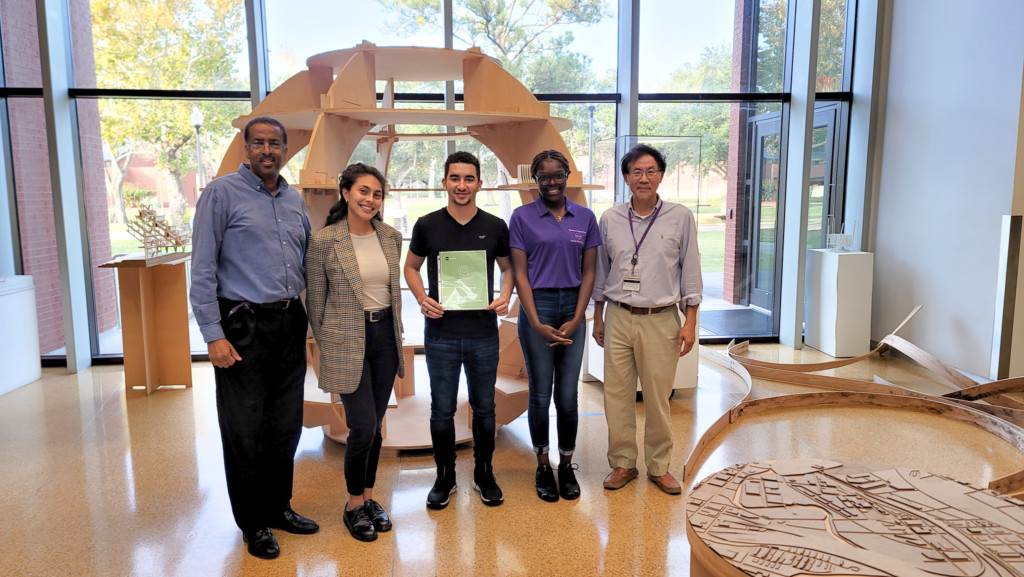PRAIRIE VIEW, Texas (December 3, 2021) – A trio of Prairie View A&M University architecture students recently took second place in a statewide student architectural design competition. Alexis Adjorlolo, Jimena Duran Castellanos and Carlos Manuel Vivero, led by faculty advisors William Batson and Stephen Song, won a cash prize and invaluable exposure during the 16th annual Gulf Coast Green Symposium, which AIA Houston hosted virtually.
With the theme of the 2021 conference being Environmental Equity, student teams (three from PVAMU and three from Rice University) were tasked with designing a “Self-Help Hub” for residents of Houston’s Freedmen’s Town neighborhood to use during emergencies. The space would have to be able to house materials “to help residents address their infrastructure-related issues during an emergency, such as sewer backups, hurricane preparedness and response, insulation, backup power, Wi-Fi accessibility, phone access, etc.,” according to the competition guidelines.
As the conference materials pointed out, minority and lower socioeconomic neighborhoods frequently bear the brunt of the impacts of unhealthy, energy inefficient, and disaster vulnerable buildings. These communities have been historically underserved and displaced through policy and lack of representation. These chronic stressors are amplified in times of disaster due to their vulnerable locations and fewer resources for recovery. “How do we reduce these disparities and create vibrant, equitable places for everyone?” the materials said.
Adjorlolo said this question animated PVAMU’s team to ensure their design be something that could be replicated in a variety of neighborhoods, even if all teams were directed to design to the Self-Help Hub’s proposed site — a 1,525 square foot lot between existing two-story residential units and across from a small park at 1605 Cleveland Street in Houston.
Innovative Resolutions
The team’s solution to the issue of full accessibility to the Self-Help Hub was to place a ramp around the perimeter of the building, something that Castellanos called “one of the most intelligent things we added to the project.” The ramp kept the building’s central portion open and provided storage capability underneath the ramp, a detail that would aid the space’s functionality as it is converted to different uses.
“One of the things the judges thought was unique and doable was our strategy of converting the interior space from a shelter format to more of a registration format,” Adjorlolo said. “In some instances, we could transform the first floor into housing — beds — and the space could also be converted to a small food hall with an open buffet kitchen, mostly by moving furniture around.”
The team worked on their project with last winter’s freeze still fresh in their minds. So, in addition to power generators as part of their design’s infrastructure, Prairie View A&M’s student designers specified external sources, such as miniature vertical windmills (such as those one might see in a strip-mall parking lot, affixed to light poles and powering the outdoor lighting) to make and conserve power for later use during blackouts.
Opening the Door to the Future
The award’s jury panel included community leaders from the Freedmen’s Town Conservancy, as well as design professionals from Kirksey Architecture, Gensler, and Walter P Moore, just a few of the event sponsors from the building trades. Castellanos was the team’s sole representative at a post-competition gathering in Houston, and she felt that the design competition “might open doors” to future jobs. As a graduate student, her entry into the architecture world is imminent.
Adjorlolo, on the other hand, is due to receive her undergraduate degree at the end of this semester and will be looking forward to graduate work. “I feel the design competition was an opportunity to grow our skills in research and design,” she said, “and find what fits in our design and presentation styles.”
Of the team’s eventual design, Castellanos said, “It was a really interesting project to be a part of. I really liked working as part of a team, representing my school, and working on a project where we can feel like we are doing something that is benefiting a historically black community and maybe something that can be done in other communities, also.”
“The really fun thing was that everyone had a completely different design,” added Adjorlolo. “One group had come up with a movable self-help hub, and another had gone back to the older housing style of the neighborhood but made it a more publicly accessible space rather than an actual home. It was interesting to see how everybody interpreted the brief and brought in their perspectives and ideas for it.”
By Andrew Cohen
-PVAMU-

